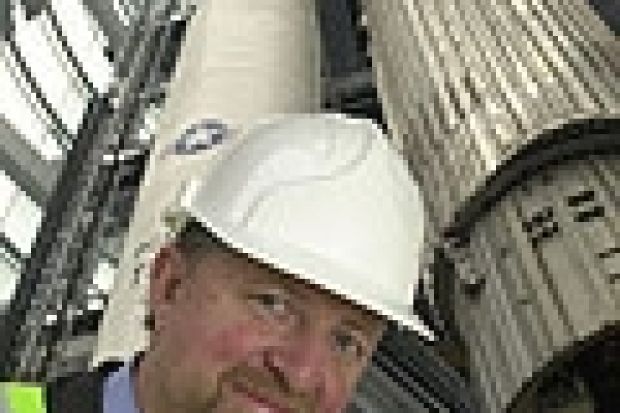Leicester's National Space Centre could rocket the country's space science into a more visible orbit. Tony Tysome reports.
Leicester University's ten-year ambition to create a National Space Centre finally rocketed into reality this month. The efforts of academics and managers at the university, backed by Millennium Commission money and in partnership with local authorities and British Telecom, have materialised in the form of a £52-million attraction designed to showcase live space research as well as to entertain and educate.
Perched conspicuously on a brownfield development site about ten minutes' drive from the university campus, the centre's translucent beehive tower housing rocket artefacts looks like an alien installation from The X Files. But there is nothing fictional about the work that will go on inside.
Despite the theme-park feel about the complex, which its designers hope will help to attract about 300,000 visitors a year, it will also accommodate more than 60 scientists and astronomers working on projects in a space-science research unit (SSRU).
The SSRU will mean that academics and students from the university's space science centre - part of its department of physics and astronomy - will be able to carry out a wide range of research in the public eye.
Alan Wells, director of the research centre, explains: "One of the key elements of the space science centre is to integrate our research programmes into the public exhibition aspect of it. This is very good for us because it means we have to think very seriously about how we present our science to the wider public. They can see real scientists at work doing real research."
He is aware that it will be important to be careful in deciding which of the research centre's project to put on show. "Most scientific research is not particularly interesting to watch - a lot of it is tedious and repetitive. But people may be more interested to see some of the end products of research and the complexity of some of the equipment needed to put things in space," he says.
The centre, however, will not be short of a choice of leading-edge projects to display. Leicester University's publicity cites the fact that since 1967, there has been something in space every year that was built in Leicester.
According to Nigel Seisage, Leicester's assistant registrar and project director for the space centre, the university's long involvement in space research was a key factor in its winning the crucial bid for Millennium Commission funds.
"The advantage we had was that we were already doing the research and had an international reputation, so we were prepared to commit intellectually to thelong-term running of the project," he says.
Some of the missions under way or in preparation are good bets to capture the public imagination. Perhaps the most obvious is the research centre's involvement in the Mars Express Beagle 2 mission, to put another lander on the surface of Mars in June 2003. And Leicester scientists' role in the continuing search for life on the red planet provides an ideal showcase opportunity.
The centre will be the base for a Beagle operations unit, and will house a full-size replica of the lander and a simulation of the Martian surface so that scientists can rehearse using a robotic arm on the lander to dig for soil samples for chemical analysis.
Also on show will be scientists and students monitoring and measuring gamma-ray bursts in deep space through the Nasa-funded Catsat satellite, in collaboration with the University of New Hampshire.
Public interest is expected to be further stimulated by the centre's interactive educational facilities. These include a multimedia, domed "space theatre": a modern planetarium that can provide 3-D views of space and space missions. The university's Challenger Learning Centre, which allows visitors to take part in simulations of space missions and research, has also been relocated to the centre.
Wells says one of the objectives of the centre's educational programmes was to catch the imagination of young people and "carry that early enthusiasm for space that you get in the ten to 13-year-olds through to the age where kids start to get more cynical when they are making education choices".
As far as the attraction of space for would-be scientists is concerned, though, he thinks the centre will be helping to push at an open door.
"One interesting indicator is that despite the decline of physics in undergraduate recruitment, our course, called physics with space science, has become the most popular in our department, with astrophysics coming second. I think that says a lot about the level of interest in space," he says.
